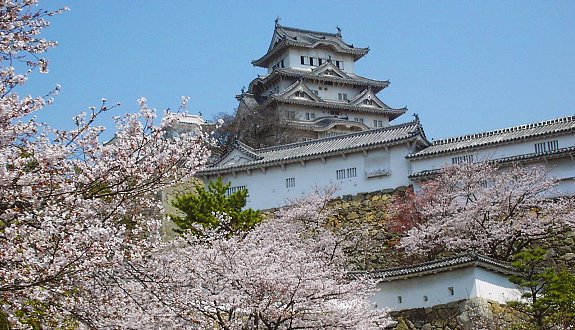Castles have been in use in Europe since the Middle Ages, serving as fortified structures and usually as the residence of lord or noble. The earliest fortifications were in the Fertile Crescent, the Indus Valley, Egypt, and China. Japanese castles evolved from wooden stockades and came into their best-known form in the 16th century. Castles in Japan were built to guard important or strategic sites, and almost always incorporated the landscape into their defense. Not usually fortified, palaces are grand residences, home to royalty, heads of state or other high-ranking dignitaries. Some of the best examples of that can be seen in the magnificent heritage properties of India that now serve as luxurious hotels. Here are some favorites.

Himeji Castle in Japan
Himeji Castle
Himeji, Japan
Known also as White Heron Castle with its remarkable white exterior, Himeji is the most visited castle in all of Japan. It was the first national landmark to be added to UNESCO’s World Heritage Sites list. The castle started as a fort in 1331 but over the centuries, the ruling warlords each left their mark, adding to the structure. The Himeji Castle complex of today was finally completed in 1609. Unlike other Japanese castles, it has never suffered serious damage due to earthquakes, fires or wars. The best time to visit this striking castle is in the first half of April, during the cherry blossom. You can incorporate this exquisite castle into your ideal Japan adventure.
Forbidden City
Beijing, China
From 1416 to 1911, the Forbidden City was the seat of supreme power in China. Four towers rise above the city walls, which are approximately one meter/three feet thick. It stands as testimony to the endurance of the Chinese civilization during the Ming and Qing dynasties. Its manicured gardens surround 114 buildings with 10,000 rooms. It houses priceless furniture and rare works of art. The Imperial Palace also contains an important library and represents the old ruling class of China. Explore this vast, ancient complex on one of our dynamic China journeys.
The Paço Imperial
Rio de Janeiro, Brazil
This Imperial Palace, previously known as the Royal Palace of Rio de Janeiro and Palace of the Viceroys, is a historic building in the center of the Rio. This is probably the least palatial looking on our list, but this 18th century residence was home to the colonial governors of Brazil. From 1808, it was used as a royal residence by King John VI of Portugal as King of Portugal, and later also as King of Brazil. Some 14 years later, it became the city palace of the monarchs of the Empire of Brazil, Pedro I and Pedro II, who used it not as a residence, but as a workplace. It was one of the main political centers of Brazil for nearly 150 years, from 1743 to 1889. The Paço Imperial is also remembered as the place where Princess Isabel signed the Lei Áurea in 1888, the law abolished slavery. It is one of Brazil’s most important historic buildings and today serves as a cultural center. Explore all that Brazil has to offer
Balaram Palace
Balaram, India
Now a luxury resort, Balaram Palace was once the hunting retreat of the Lohani Nawab of Palanpur. It was built between 1922 and 1936 by the 29th ruler of Palanpur. Its graceful form is in the neo-classical and baroque architectural style. It sits amid the Aravallis Mountains in the Balaram Ambaji Reserve Forest at the tip of North Gujarat bordering Rajasthan. The palace features 13 acres of terraced land rising from a hilly stream and surrounded by lush green gardens and designed flower beds. Discover India’s extraordinary heritage hotels on India – Gujarat & Karnataka, and our other India passages.
Potala Palace
Lhasa, Tibet Autonomous Region, China
The Potala Palace is a graceful but monumental structure in Tibet. Rising high on a hill above the Lhasa Valley, it was built in 637 CE by Emperor Songtsen Gampo. In the 17th century, the palace was integrated into the foundations of some of the greater Tibetan buildings you still see today. The construction required more than 7,000 workers and 1,500 artists and craftsmen to complete. The palace now houses dazzling artifacts on display for the world to see. Tibet is on many serious travelers’ must-see lists. If it’s on yours, take a look at Tibet: Legends of Shiva.